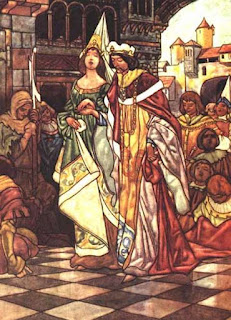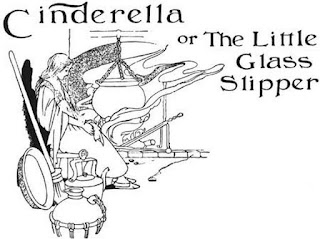Sleeping Beauty
Sleeping Beauty by Charles Robinson
Sleeping Beauty or Briar Rose is a classic fairy tale known in several versions. This one belongs to the brothers Grimm with one exception - the king and the queen left the castle after their princess fell asleep. Charles Robinson for some reason didn't illustrate the grand finale with the prince, so the story, if we confine ourselves just to pictures, ends with everybody asleep.
The frontispiece of the story belongs to The Big Book of Fairy Tales, published by Blackie & Son, London in 1911, and portrays the aforementioned scene where the royal couple leaves the sleepy castle. This scene comes from older versions, where the sleeping princess was left in the castle, but in those versions, everybody left. She was alone and unprotected (no thorns around her home either).
Briar Rose is an alternative title, given by Jakob and Wilhelm Grimm. This title is very rarely used in editions published after WW2.The wicked fairy is used for the decorative capital letter, the first letter of the story (after the title, of course). Decorative letters were very popular in the Art Nouveau era and can be found in scripts many centuries ago. Now they are almost forgotten as well.
This is one of the crucial scenes in the story. Despite the prophecy and full fifteen years for preparation, nobody looked after the princess on the day when she was supposed to prick her finger and fall asleep. So she wandered around and found a staircase to the castle tower she obviously didn't know. There she found an old lady with a spindle and we all know what happened next.Everybody fell asleep. Even the guard who was so focused on drinking, trying to find a balance between coffee and wine, stopped in the middle of his move, with a pitcher halfway to his mouth.
The famous scene with a kitchen boy who escaped his punishment because everybody fell asleep is from a dramatic point of view unimportant but still one of the most popular ones in the audience.
Well, one hundred years later, he was still punished.
Unfortunately, we didn't see the prince who came to the rescue. We have to be satisfied with the final scene - the guard from before.Yes, he finally managed to get that drink. It was a nice ending to a full century of abstination and a lovely intro to the wedding which, again, is not portrayed in this version of Sleeping Beauty.
If you want to see more, including the prince, seven good fairies, and a dwarf (yes, a dwarf with seven league boots!), you are cordially invited to visit the page with Charles Robinson's contemporary Robert Anning Bell who also illustrated the same story.
This is it:
https://robert-anning-bell.weebly.com/sleeping-beauty.html
Enjoy!










Komentarji
Objavite komentar